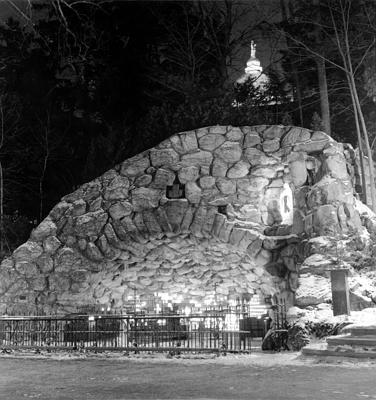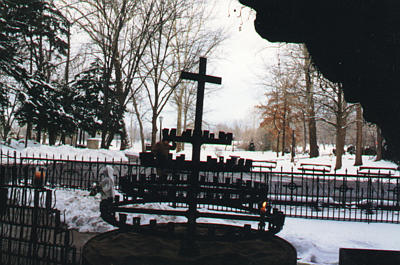
Notre Dame's Grotto / by Dorothy V. Corson


More Grotto Memories
Under the heading, "White December Finds Grotto In Usual Mood," a wintertime scene at the Grotto in 1939, the year Fred Snite returned from Lourdes, is described in the Scholastic :
And now it is December. The trees that shade her in summer, yawn their nakedness into the cold blue sky. Mossy beds of flowers that usually stretch over the rocks to her niche are tangled dry weeds. The cracking coldness of the season numbs the iron kneelers at her feet and causes lighted candles beyond to sputter and jump casting leaping shadows on the Grotto walls. But she is not alone. Even when the heavy snow will bury the weeds and clutch the tree trunks she will not be without visitors.
These Grotto visits are more than tradition at Notre Dame. They are an essential part of her life. Students cannot fail to come to this shrine of Our Lady that was erected so they can stop by at any time to offer her their problems or just to say "hello"(227)
The Dome underscores the above description with this lovely wintertime perception:
It catches the last rays of the setting sun and its snows are the whitest white of winter. Proof of the sincerity of this devotion to Mary can be seen on any inclement evening when there are still hundreds making the trek to the Grotto to make their day complete. Private visits to the Grotto afford an excellent opportunity to pause for a moment during the day, perhaps to light a candle and speak to Mary about one's problems and decisions.(228)
Another added improvement to the Grotto is noted in the Scholastic :
On the right side of the Grotto a statue of the Blessed Virgin stands in an elevated niche. This is illuminated at night, the result of the work of Rev. Lawrence V. Broughal, C.S.C., for many years faculty advisor of the Scholastic , who also had the stairway lights installed.(229)
In the early 1940s, new artforms in sculptures appeared on the campus. The university inaugurated a beautification project to fill the many empty niches in the buildings on campus with sculptures. Seventeen sculptures were completed by Rev. John Bednar, head of the art department, and Eugene Kormendi, artist in residence and teacher of sculpture. The World War I portico in the east entrance of the Sacred Heart Church was completed in May of 1944 and the Grotto received its own piece of art:
In addition to plans for the erection of the statues, the university's art program will take in other aspects of art on the campus. A three sided drinking fountain sculpture by William John Schickel, former student of Ithaca, N.Y., has been completed. The theme of the work is carried out with relief depictions of Our Lord at the well, Our Lord preaching from the boat, and Our Lord washing the feet of his disciples. Mr. Schickel worked under the direction of Fr. Bednar and Mr. Kormendi.(230)
The three sided sculptured drinking fountain replaced the earlier one which was in the same spot at the Grotto where the natural spring appeared. Many a toddler has since put his foot in the lap of the Lord in boosting himself up to get a drink from the Grotto fountain.
Another poignant letter associated with the Grotto was published in the Scholastic. It was written by the mother of Lt. Lawrence A. Barrett, in remembrance of her son. He died in a plane crash in 1941 at the beginning of World War II.(231)
With the coming of the warm weather, students have begun to wend their way back to their halls by way of the Grotto each night after supper. This hymn-singing has long been a tradition of Notre Dame. As the mother of the late Larry Barrett, graduate cum laude with the class of '40, wrote to the students right after his death in an airplane crash:
"How glad I am that Larry had those happy years at Notre Dame. He carried from there his habit of living his faith; if ever a boy used his religion, he did, with all his heart, as he did everything. I have a comforting little belief that on May evenings when the boys are at the Grotto, his dear deep voice rises again . . . 'Macula non est in te' . . . such a host of Her Notre Dame boys are even nearer to Her now, young and fine forever."
The article concluded with a mention of one of those students who wended his way back to his hall by way of the Grotto:
The Prefect of Religion pointed out that one of the greatest athletes of Notre Dame fame, chunky Greg Rice, two-miler superb, was one of the most frequent visitors to the Grotto. Many stories are told of how Greg would wrap himself in a towel to protect himself from the bitter Indiana weather, and would spend a short time each night at the Grotto.
A memorial was placed at the Grotto for another pilot who also lost his life during World War II. He was killed in an airplane crash on July 27, 1943.(232) The embossed wording on the black hand rest of the kneeling railing is hidden, but easily discerned by anyone who stops to read Tom Dooley's letter. The same lettering is also on the circular candle tiers in the candle area. It has been repainted many times which has made it almost indiscernible. It reads: "In memorial to Paul Purcell 1943."

Paul Purcell graduated from Notre Dame University in 1940. He was the only athlete at Notre Dame to receive a special sportsmanship award as a result of his boxing. He must have had a special devotion to the Grotto and the memorial was placed there by his family, in remembrance, to perpetuate that devotion.
Eight years later, during and shortly after the Korean War, two more "Favor Granted" plaques, the last ones, took their places on the weathered rock walls of the Grotto. One appeared on January 28, 1951, bearing the initials, J.L.B., and the other on August 3, 1954, bearing the initials, M.H.M. Like the one placed there in 1918, during World War I, the remaining two plaques mounted on the Grotto also have stories to tell that may never be known.
They will always be something for visitors to wonder about. Since plaques are no longer allowed on the Grotto, they now have a special distinction; they must represent the heartfelt gratitude of all answered prayers.